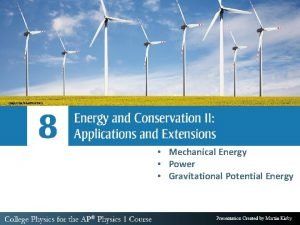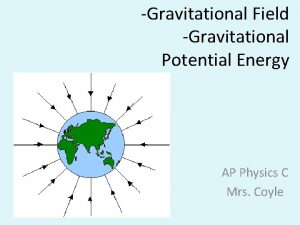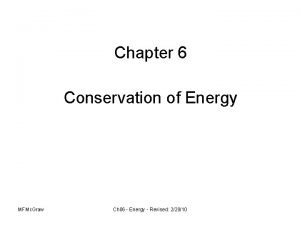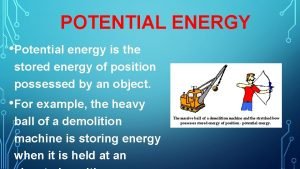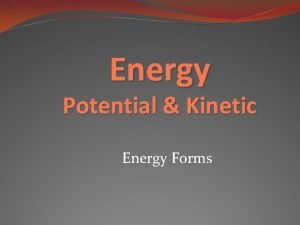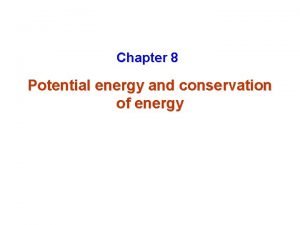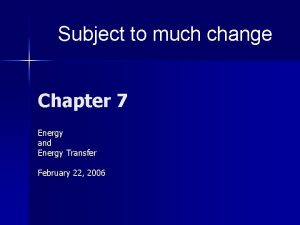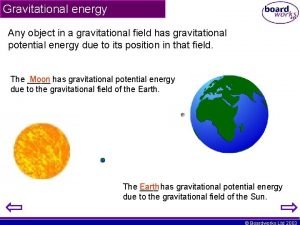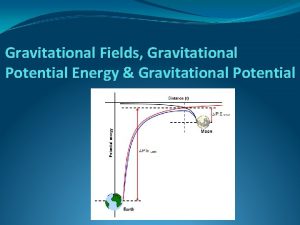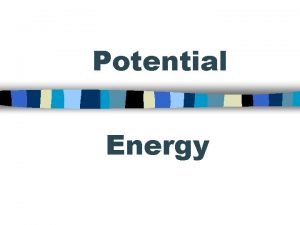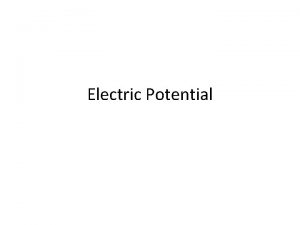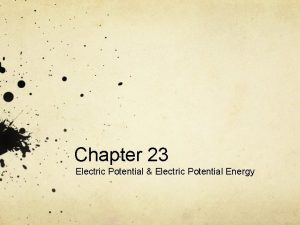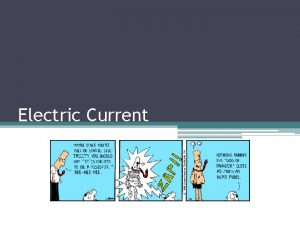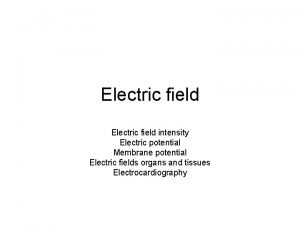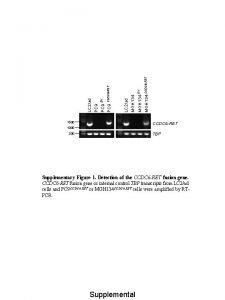Electric Potential Gravitational Potential Energy A GPE mgh
























- Slides: 24

Electric Potential

Gravitational Potential Energy A GPE = (mg)Δh GPE = mgh. A – mgh. B B h. A h. B F = mg GPE = Work (W) required to raise or lower the book. -Where W = (Fgravity)(Δh)

Electric Potential Energy + + + + + ΔPEE = (qo. E)Δd = Fd = W A ΔPEE = qo. E(d. A – d. B ) + Fe = qo E W = ET = ΔPEE d. A B + d. B - - - Fe = qo E - - • Does a proton at rest at point A have more or less potential energy than it would at point B? More -

Electric Potential Energy of Point Charges and Work n n n Much like the book is attracted to the earth due to gravity, two unlike charges are attracted to one another. Conversely, like charges repel. It takes positive work to move unlike charges away from one another and like charges closer together. F +q F -qo F F +q +qo

Electric Potential Energy 1. What would happen if the charged particle q was fixed in place and then particle qo was suddenly released from rest? A. It would accelerate away from q. It would accelerate towards q. It would stay where it is. B. C. 2. How would the potential energy of this system change? A. It would increase. It would decrease. It would remain the same. B. C. -qo +q

Electric Potential We know that W = Fd = q. Ed. We can define the amount of work per unit of charge as This is also called V (voltage) or potential difference. (You could conceive of an analogue as work / unit mass, although I know of no use for it: )

Electric Potential SI Units: joule/coulomb = 1 volt (V) n The Electric Potential is the energy per unit of charge (J/C). n We may write it as to emphasize the fact that it is a potential difference and that the “zero” is arbitrary (like gravity)

Example 1: Electric Potential n An object with 2. 5 C of charge requires 1. 00 x 10 -3 Joules of energy to move it through an electric field. What is the potential difference through which the charge is moved?

Characteristics of a Capacitor Two equal and oppositely charged plates + + + + qo B E qo C qo A - Uniform Electric Field • Since the electric field is constant, the force acting on a charged particle will be the same everywhere between the plates. • Fe = qo. E FA = F B = F C

Electric Potential and Work in a Capacitor WAB = F·d. B - F·d. A WAB = qo. E d V = WAB qo + + + + D A B qo qo F = qo. E d. B F = qo. E d. A C qo If WAB = qo. E d, then what is WCD? WCD = 0 Joules because the force acts perpendicular to the direction of motion. • Do you remember that W = F·d·cos ? -

Electric Potential of a Capacitor – An alternative n n n From mechanics, W = Fd. From the previous slide, W = qo. Ed From the reference table, V = W/qo Two equal and oppositely charged plates + + + + A B qo F = qo. E Uniform Electric Field d - V = WAB/qo = Fd/qo = qo. Ed/qo = Ed

Example 2: Parallel Plates A spark plug in an automobile engine consists of two metal conductors that are separated by a distance of 0. 50 mm. When an electric spark jumps between them, the magnitude of the electric field is 4. 8 x 107 V/m. What is the magnitude of the potential difference V between the conductors? V = Ed V = (4. 8 x 107 V/m)(5. 0 x 10 -4 m) V = 24, 000 V d

Example 3: Parallel Plates A proton and an electron are released from rest from a similarly charged plate of a capacitor. The electric potential is 100, 000 V and the distance between the two plates is 0. 10 mm. 1. 2. 3. 4. 5. Which charge will have greater kinetic energy at the moment it reaches the opposite plate? Determine the amount of work done on each particle. Determine the speed of each particle at the moment it reaches the opposite plate. Determine the magnitude of the force acting on each particle. Determine the magnitude of the acceleration of each particle.

Example 3: Parallel Plates(cont. ) + + + + n p+ e- d - Begin by drawing a picture and listing what is known: n n n V = 100, 000 V d = 0. 10 mm = 1. 0 x 10 -4 m qe = qp = 1. 6 x 10 -19 C (ignore the sign. We are only interested in magnitude. )

Example 3: Parallel Plates(#1 & #2) n For #1, you could answer #2 first to verify. n The answer is that the kinetic energy of both particles will be the same • Why? • because of the formula needed in question #2 applies to both charges, and work = energy. • Hence: Wproton = Welectron qproton. V = qelectron. V Wproton = Welectron = (1. 6 x 10 -19 C)(100, 000 V) Wproton = Welectron = 1. 6 x 10 -14 J

Example 3: Parallel Plates(#3) n n Apply the work-energy theorem to determine the final speed of the electron and proton. W = KE Since the initial kinetic energy is equal to 0 J: W = KEf W = ½ mvf 2 n Proton: n Electron:

Example 3: Parallel Plates(#4) n n Since F = q. E, it will be the same for both particles because their charges are the same and the electric field is uniform between two parallel plates. We also know that W = F d. Since we know the distance between the plates and the work done to move either charge from one plate to another, we can determine the force as follows:

Example 3: Parallel Plates(#5) n Since we have the force acting on each particle, we can now calculate the acceleration of each particle using Newton’s 2 nd Law.

Equipotential Lines n n Equipotential lines denote where the electric potential is the same in an electric field. The potential is the same anywhere on an equipotential surface a distance r from a point charge, or d from a plate. No work is done to move a charge along an equipotential surface. Hence VB = VA (The electric potential difference does not depend on the path taken from A to B). Electric field lines and equipotential lines cross at right angles and point in the direction of decreasing potential.

Equipotential Lines n Parallel Plate Capacitor Lines of Equipotential + + + + Decreasing Electric Potential / Voltage - Electric Field Lines Note: Electric field lines and lines of equipotential intersect at right angles.

Equipotential Lines n Point Charge Note: Electric field lines and lines of equipotential intersect at right angles. Lines of Equipotential + Decreasing Electric Potential / Voltage Electric Field Lines Note: A charged surface is also an equipotential surface!

Equipotential Lines (Examples) n http: //www. cco. caltech. edu/~phys 1/java/phys 1/ EField/EField. html

Key Ideas n n n Electric potential energy is the work required to bring a positive unit charge from infinity to a point in an electric field. Electric potential (V) is the change in energy per unit charge as the charge is brought from one point to another. The electric field between two charged plates is constant meaning that the force is constant between them as well. The electric potential between two points is not dependent on the path taken to get there. (Similar to gravity and gravitational PE. ) Electric field lines and lines of equipotential intersect at right angles.

Electric Potential We know that W = Fd = q. Ed. We can define the amount of work SI Units: joule/coulomb = 1 volt (V) n n The Electric Potential Difference is equal to the Work required to move a test charge from infinity to a point in an electric field divided by the magnitude of the test charge. The Electric Potential is the energy per unit of charge (J/C).
 Electrostatic potential energy definition
Electrostatic potential energy definition Si unit of electric potential
Si unit of electric potential Mgh si units
Mgh si units Total energy formula
Total energy formula Gravitational potential energy vs kinetic energy
Gravitational potential energy vs kinetic energy Units of electric potential energy
Units of electric potential energy Expression for electric potential difference
Expression for electric potential difference How is potential energy used
How is potential energy used Gravitational potential energy
Gravitational potential energy Gravitational potential energy
Gravitational potential energy Work done by normal force
Work done by normal force Gravitational potential energy
Gravitational potential energy Mechanical energy examples
Mechanical energy examples Thermal energy formula
Thermal energy formula What is the formula of potential energy
What is the formula of potential energy Friction energy
Friction energy Gpe formula rearrange
Gpe formula rearrange Mechanical advantage
Mechanical advantage A heavy container has been raised up above ground level
A heavy container has been raised up above ground level Electric potential energy formula
Electric potential energy formula Equation for electric potential energy
Equation for electric potential energy Potential energy due to point charges
Potential energy due to point charges Electric potential electric field
Electric potential electric field Define electric potential and potential difference.
Define electric potential and potential difference. Electric potential
Electric potential







